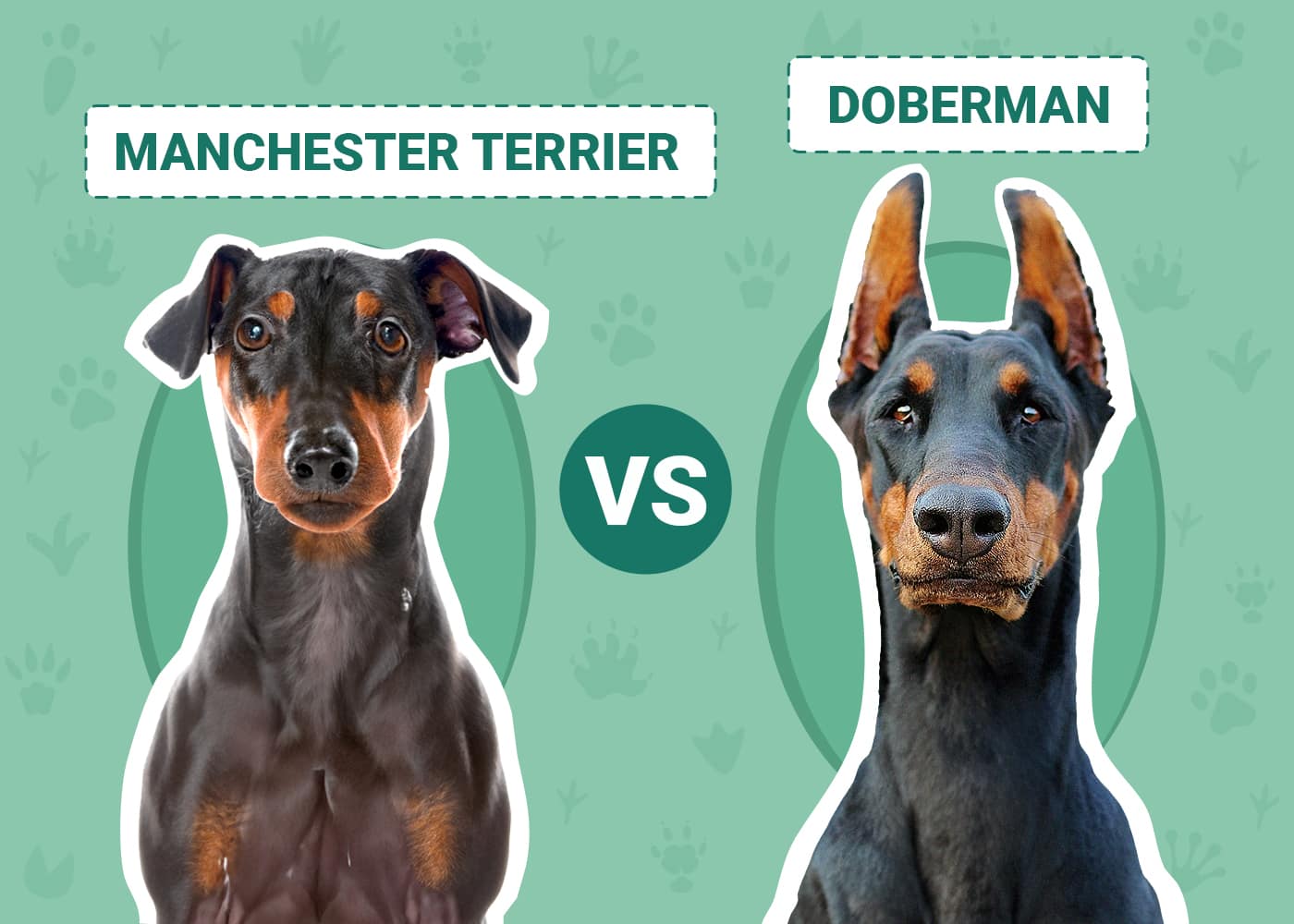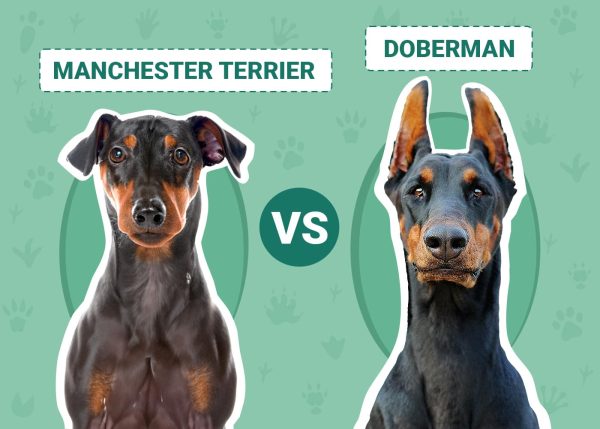Click to Skip Ahead
The Manchester Terrier and Doberman look similar, but they have several differences. Incidentally, the two breeds ended up being very similar in looks despite being bred in different countries from different “starting” breeds. The Manchester Terrier was developed in Manchester, England, and the Doberman was bred in Germany by a tax collector. These dogs are both outstanding canines; read on to discover which breed is ideal for you.
Visual Differences

At a Glance
- Average height (adult): 15–16 inches
- Average weight (adult): 12–22 pounds
- Lifespan: 14–16 years
- Exercise: 1+ hours a day
- Grooming needs: Minimal
- Family-friendly: Yes
- Other pet-friendly: Often
- Trainability: High energy, eager to please, tenacious
- Average height (adult): 25–28 inches
- Average weight (adult): 71–90 pounds
- Lifespan: 9–12 years
- Exercise: 2+ hours a day
- Grooming needs: Moderate
- Family-friendly: Yes
- Other pet-friendly: Tolerant
- Trainability: Highly intelligent, easy to train, bred to take commands
Manchester Terrier Overview
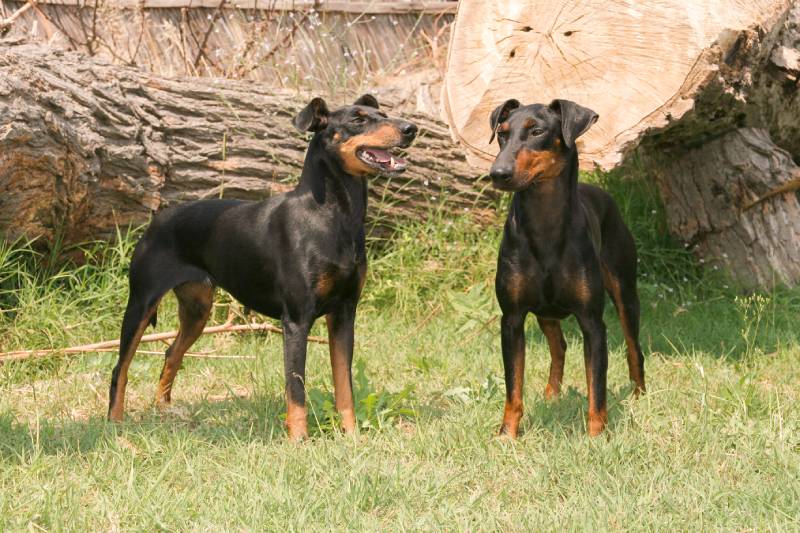
These little dogs are full of tenacity and bravery and were bred for the urban jungles of Manchester, England, primarily to catch rats.
Personality / Character
Loyalty would be the first word to describe Manchester Terriers as a breed. The brave and bright dogs don’t trust easily, but once their trust is earned, it’s never forgotten. They stick close to their families but aren’t opposed to strangers, being largely indifferent by nature when meeting strange dogs or people. However, if socialized well, they can be warm and inviting to other dogs and devotedly love their families.
Training
These dogs are intelligent and eager to please; you may have to work to keep their focus as they have such high energy. Manchester Terriers are keen to learn, and their smaller size helps with agility, belying their ratting pasts.
However, they can be stubborn, and the trait can creep into training sessions, so keeping them short and sweet can help maximize your pup’s training potential.
Health & Care
The Manchester Terrier is relatively healthy for a purebred dog, but in the toy variety, they are subject to some common health problems as well as those that are common in the regular variant.
Manchester Terriers have several health conditions that occur more often in the breed than others, such as Von Willebrand’s disease (an inherited blood clotting disorder), hypothyroidism, and glaucoma.
There are also more size-specific problems they’re prone to, like luxating patella (dislocation of the knee) and Legg Calve Perthes disease (wasting disease of the femoral head).
However, these can all be tested for, and any puppies you decide to buy should have been tested for the conditions before being sold.
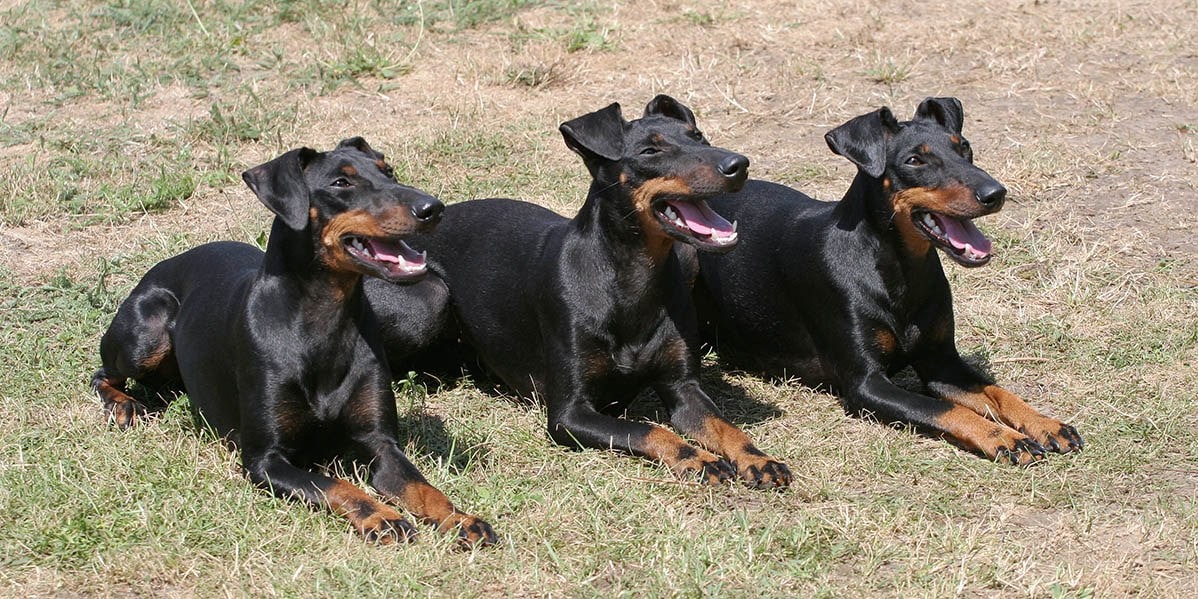
Exercise
The Manchester Terrier is highly athletic and intelligent and needs lots of mental stimulation and physical challenges to be kept happy. Longer walks, games like fetch, and the opportunity to dig (the hallmark of a terrier) can keep your Manchester Terrier entertained and ensure it’s tired out and ready for a good long rest.
Suitable for:
Manchester Terriers are suitable for families with experience with active breeds. They also suit single owners who can devote more time to keeping their dogs healthy and stimulated. The toy variant is particularly suitable for apartment living as its small stature doesn’t take up much space. Otherwise, Standard Manchester Terriers will need a large outdoor area.
- Toy and standard varieties
- Intelligent
- Eager to please
- Minimal grooming needed
- Highly active, need an active household
- Can be stubborn
- Toy breeds may not be suitable for small children
Doberman Overview

The Dobermann or Doberman Pinscher originated from Germany and was created by the tax collector Louis Dobermann, which is where it gets its name.
Personality / Character
The Doberman is intelligent and devoted to its family and was bred for protection. This protective facet of their personality carries on through the more peaceful Dobermans of today.
They can be weary of strangers and on high alert, but once they get to know you, the Doberman will be loving and begging for your attention. They have an understandable but undeserved reputation for aggressiveness, partly due to their appearance.
Training
Because of the Doberman’s high intelligence (ranked by psychologist Stanley Cohen as the fifth most intelligent breed of all), training them is a breeze. In addition, the Doberman has the innate ability to follow commands with precision on a hair trigger, making it a fantastic guard dog. Dobermans can pick up new tricks and orders effortlessly and perform them fluidly, with their only goal being to do their job and do it well.
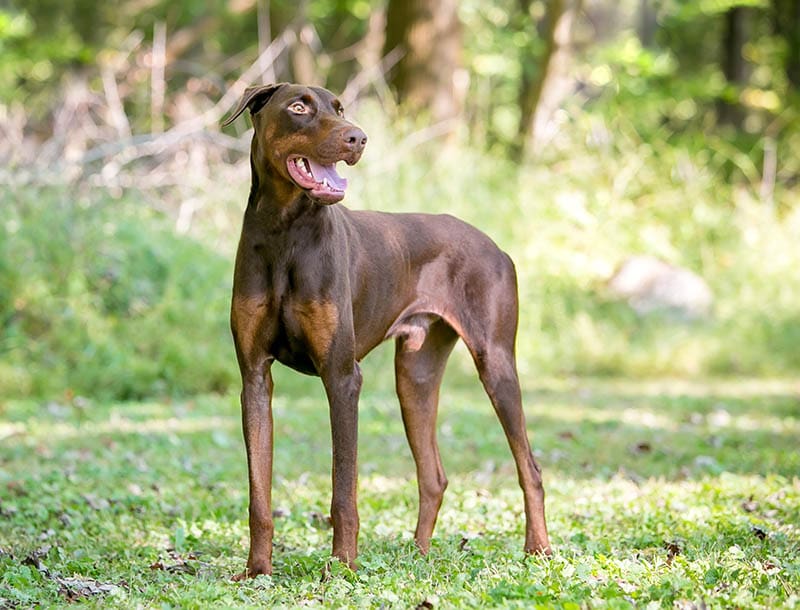
Health & Care
The Doberman is vulnerable to contracting dilated cardiomyopathy (or DCM). DCM seems to be worse in Dobermans, with almost 40% of DCM diagnoses in America being Dobermans. This diagnosis is lethal in around 50% of cases.
Besides this disease, Dobermans need minimal care other than regular health checks and claw clips, but their coats shed a lot, so daily grooming to remove dead hair is essential.
Exercise
Dobermans are fast and compact and need the space and opportunities to burn off energy and stretch their legs. Dog parks with agility courses are excellent for this, as well as long rambling walks and playtime with family members. They would not suit a family who lives in an apartment since they need a yard to play and exercise in. Just don’t be surprised if you see them patrolling the perimeter.
Suitable for:
Dobermans are suitable for families ready for an energetic, medium-breed dog. People with some experience with working breeds will have an easier time with training. Singles will find a very loyal and close companion in the Doberman, and the dogs are also good with children and very protective of their families.
- Incredibly affectionate
- Loyal
- One of the most intelligent dog breeds
- Heavy shedding
- Powerful and protective
- Can be wary of strangers

Cost Manchester Terrier vs Doberman
The Manchester Terrier is a smaller dog and won’t need as much food as a Doberman. They also don’t need as much grooming as the Dobermans. Grooming a Doberman is a must to keep the floors free of hair, unlike the Manchester Terrier’s sleek, short, close coat that doesn’t shed half as much.
The cost of grooming equipment such as gloves, brushes, and shampoos isn’t high, but it’s something to consider, particularly if you have to spend extra on professional grooming.
Because of their predisposition to serious health problems, a Doberman may cost more to insure and more in vet bills if they get sick, whereas the Manchester Terrier lives longer and may cost more over time.
Which Breed Is Right for You?
If you have a small family or are living in an apartment and are looking for an energetic and fun dog without the seriousness of a dog with a job, the Manchester Terrier may be an option. However, some experience with Terriers is recommended since the Manchester Terrier’s ratting instinct can make them irritable if they aren’t given regular exercise.
They are sweet and loving with their family, and the toy variants can adapt to smaller households. The Doberman is the classic image of a protector. While its harsh exterior can make it seem off-putting to strangers (precisely what it was bred for), the Doberman is loving and devoted to his family members, doing everything it can to be the world’s biggest lap dog.
However, Dobermans need more space to live comfortably. They suit families with kids as long as the dogs receive the proper obedience training. Both dogs are loyal and devoted and would be excellent additions to any household.
Featured Image Credit: Top – Ricantimages, Shutterstock | Bottom – Kseniia Kolesnikova, Shutterstock

